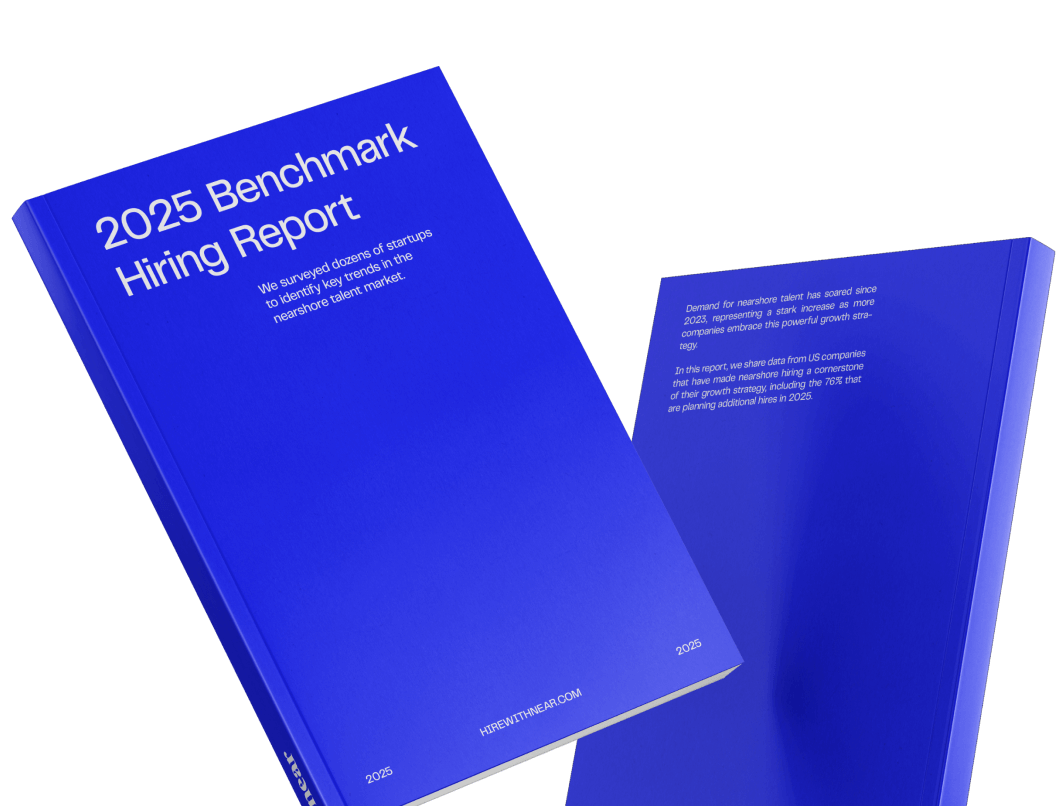After 2 years of helping U.S. companies identify and hire the best talent in Latin America (and hiring several teammates ourselves), we’ve learned some valuable lessons that are worth passing on to any company thinking of doing the same. Hiring in LatAm can be a cheat code for U.S. businesses — from creating greater operational leverage by scaling teams of junior folks, to saving hundreds of thousands of dollars per year on highly qualified, bilingual talent. We want to make you aware of the host of opportunities and challenges that come with hiring LatAm talent so you can get the most out of the hiring process and your new teammates. These are the top 9 lessons that we’ve learned from hiring in LatAm:
Lesson 1: There Are Several Clear-Cut Benefits to Hiring in LatAm
Lower salaries, highly qualified talent
Salaries in Latin America are significantly lower than in the U.S. In fact, you can hire talent for 30-50% less than the market rate U.S. salary for a similar hire. Given the fluctuating economic conditions and rapid inflation across the region, virtually any candidate would jump at the opportunity to work remotely for a U.S.-based company and earn in USD (an inflation-protected currency).
And even though companies can save upwards of 50% on salaries, candidates will earn 2 to 3 times as much in salary as they could locally. This creates a huge opportunity for U.S. companies who want to retain top talent. By paying just a bit more, U.S. companies can still save big-time on salaries while keeping their new teammates extremely satisfied, engaged, and committed for the long run.

Time zone alignment
Unlike other popular, but far-away outsourcing and offshoring locations (like the Philippines, India, and Eastern Europe), no country in Latin America is more than 2 hours ahead or behind EST. This is a game-changer for hiring remote talent. Instead of hiring offshore “resources,” time zone alignment in Latin America allows U.S. companies to hire remote teammates who can work the same hours, be a part of the team, and add to company culture. Additionally, LatAm contractors and employees are much more willing to work North American hours than their counterparts in more distant countries (e.g., The Philippines, India and Eastern Europe).
Creating diverse teams
Hiring a diverse workforce is crucial in 2024, and in order to build a diverse workforce, companies need to source talent from various sources. Identifying new regions, cultures, universities, and other places to hire from is an effective way to bring teammates with differing perspectives and experiences to the table. That’s why 3 out of 4 companies are saying that diversity and inclusion are a top priority for them.
Companies that fail to move with the social tide are increasingly being seen as outdated, and this is starting to impact their bottom line. Think about it - how effective can a company built with teammates from the same socioeconomic background be at recruiting talent outside of their bubble? How can companies create diverse teams that share more in common with customers? That’s why on top of creating diversity for the sake of having new perspectives at your company, there's a practical benefit to hiring teammates from different backgrounds. Diverse companies are reported to be 70% more likely to win business in new markets.
So how does this relate to hiring Latin American talent? By recruiting candidates from new regions, companies can instantly improve diversity from a culture, ethnicity, language, and experience perspective. U.S. businesses who embrace nearshoring talent from Latin America can be more effective from an HR perspective, all while boosting profits and keeping your team working in the same time zone. The strongest employers and brands in today’s remote-first world will hire.
Strong English levels
One of the things we get asked about most is English language fluency. It’s understandable - especially if hiring from countries where English isn’t the first language is new to you. In our experience, though, it doesn’t need to be a problem. Just like any other popular outsourcing location, like India or Eastern Europe, LatAm workers have different levels of English ability. Some will speak flawless English, and they’re going to slot right in at your company. Others might have perfect reading and writing skills, but don’t speak like a native. Workers like this will be great for roles that don't require customer facing conversations, like customer support chat reps, software developers, and administrators.
Over 10% of Latin America have strong English skills, and that percentage is even higher among working professionals. The only challenge is ensuring you’re choosing the right talent. So how do you make sure that your language requirements are met when hiring in LatAm? Well firstly, you need a strong vetting process. Putting strong internal processes in place to vet all applicants is difficult, but choosing the right partner can make this easy. A good nearshoring partner will have their own systems in place to vet language ability, that will save you time trying to figure out the best way to test applicants. We’ve scaled the majority of our team with LatAm talent, and have done the same for hundreds of customers.
Work ethic
Working culture in Latin America is pretty similar to the U.S.; LatAm employees are extremely diligent, hard-working, and perform at a consistently high level. But there are some differences that U.S. firms can actually find quite useful. The most notable is how they view relationships. The U.S. has an individualistic culture, where success is measured on a personal level. Latin America, however, has a collectivist culture, which means that they put the team’s success first.
What does this mean? Well, generally you’re going to get a workforce that’s more motivated. When employees understand that others are relying on them to do a good job, it leads to better performance across the board. It also leads to better views of the company, often as more of a family than a faceless organization. This leads to loyalty, which is a big pull for US firms that are struggling with retention now more than ever thanks to ‘The Great Resignation’.

Lesson 2: There Are Also Some Not-So-Obvious Benefits
Reduce hidden overheads
We’ve discussed salaries, but any business owner will know that when it comes to staff, that’s not all you’re paying for. The cost of hiring office space is most likely one of your biggest expenses. In New York, it averages about $14,000 per employee for a year. On top of this, you’re probably used to paying for things like coffee, printer ink, and even smaller purchases like hand soap can add up.
If you’re building a remote team, you can bypass the costs associated with traditional office settings entirely. Will your employees feel like they’re losing out without the office perks, though? Well, that’s not what we’ve found. Employees working remotely are reportedly 20% happier on average than those who aren’t. It’s a win-win.
Mitigate risk
Do you know any businesses that outsource labor to Eastern Europe? Perhaps you’ve even been doing this yourself? If so, you’ll be aware that the last year has been a tough ride. The conflict in Ukraine has shown how important it is to decentralize your workforce to mitigate the impact of things that are outside of your control. Whether that’s war, natural disaster or economic issues, these things can seriously impact the way you do business. LatAm hiring with a good partner allows you to use a single, easily replicable approach for a region that’s diverse and varied, reducing the potential for harm to your business, without requiring you to become an expert in hiring workers from the world over.
Allows you to scale with specialists
When you’re starting a business, it pays to go with employees who can do more. Having workers who are able to handle multiple areas of the business means fewer hires, which keeps startups agile and low-cost.
However, as businesses begin to scale, a lack of specialist knowledge can get in the way of growth. To hit the next level, you have to start hiring experts, who are experienced and knowledgeable in their own niche. The biggest barrier to this? The cost. Specialists in the U.S. command high salaries, which can be a challenge for companies that need to scale fast and don’t have the backing of venture capital.
In Latin America, however, you can find ten-year data analysts, full-stack programmers, SEO experts, and more - but at half the cost. Leveraging their skills can boost productivity and output without breaking the bank, all while you provide opportunities to LatAm workers that can be preferable to those available at home.

Lesson 3: You Can Hire for Virtually Any Remote Role in LatAm
We mean that. There’s a misconception that outsourcing is only appropriate for certain kinds of roles, but in reality, the vast talent pool that Latin America offers means that you can find just about anything you’re looking for. Here are just a few of the most popular areas that we’ve helped our partners to find workers in:
- Accounting
- Marketing
- Finance
- Sales
- Engineering
- Customer Support
- Data
- Product and Design
- Operations and VAs
Lesson 4: Different Roles Have Different Salary Expectations
Not everyone is going to expect the same salary. Just like in North America, there’s a lot that goes into salary expectations, like education level, labor demand, and years of experience.
The difference when hiring LatAm workers? You’re not going to be familiar with what the going rates are. We like to say that as a rule of thumb, you can save around 50% on an equivalent U.S. salary - but paying LatAm talent isn’t as simple as just halving a U.S. wage. When you choose a reliable hiring partner like Near, you’ll get advice on what a fair salary would be for a given role. This means that you can be confident both you and your hire, are getting the best deal possible.
Lesson 5: LatAm Hiring Opens Up New Opportunities
Hiring in LatAm creates opportunities for your business to excel in areas that aren’t available to your competitors. What do we mean by this? Take your sales team, for example. The fastest way to grow is to get customers on board, something that’s made much easier with a bigger sales team that can cover more ground. The combination of lower wages, and the ability to offer contracts that focus on commission-based pay, means that you have a huge advantage in the potential size, and scalability of your sales team.
What’s great is that this can be extended to other areas of your business. Growth comes through sales, but what’s the best way to sustain it? Keeping your customers coming back for more. That’s where your customer care and support teams come in. There is an abundance of support representatives in Latin America available to hire for significantly less than in the U.S.. Our partners report that their reps are helpful, friendly, and charismatic - all the traits that keep customers feeling valued, and ensuring they come back for more.

Lesson 6: You Need a Hiring Process
As any company who has scaled their business at speed will know, hiring new employees can be messy if you don’t establish a clear structure to your employment process.
Some of the problems that companies see when hiring isn’t strategic include:
- Stakeholders and interviewers at the company don’t know where the responsibility falls. If your company doesn’t have a clear idea of who is making the final decisions, promising hires can get held up in red tape.
- People involved with the interview process aren’t aware of the process and end up wasting time. A hiring roadmap should be created and distributed to anyone who might need it, so that deals aren’t getting stuck in limbo.
- Candidates become disillusioned. The candidates you’ll be looking at are experienced professionals, which means they’re expecting a high standard of operations. If the process seems messy and slow, it’s going to impact the way they view you, and your business. Ultimately, the way you treat them in the hiring process is going to make or break whether they decide to join your company.
To avoid these issues, you should start by answering the following questions:
- Do the candidates need to speak to the founders?
- Will the candidates have to submit work samples? If so, do you have an online storage solution, like Google Drive, that they will be able to submit their sample to?
- Do your candidates need to prepare any other materials before speaking to you in interviews?
Spending an hour or two organizing these questions and thoughts will help save time for your company and prospective new team members during the hiring process. On top of that, it’s going to make your company look more professional, and help attract top talent.
Having a refined hiring process will make a big difference:
- It helps you identify and hire the best candidates faster: There will be competition for these candidates, so spotting them early will boost your chances of securing them.
- It reduces hiring costs: a shorter recruitment process can help you save time and money. How? Faster hiring means less time spent on interviews and less money spent on maintaining job posts.
- It boosts the company’s image: the hiring process is a great chance to demonstrate that your work culture is disciplined and organized. If you want to attract high-quality talent, value efficient systems, and care about people’s time.
- It helps you avoid bad hires: using means-tested screening to understand what you’re looking for helps avoid issues down the line, and can help ensure that you’re picking the right people.

Lesson 7: You Can Save Hours With a Good Screening Strategy
Before starting the recruitment process, having a good screening strategy in place is a must. Over the last 2 years, we’ve mastered this. By the time it comes to interviewing your candidate, you should already have a solid idea of whether or not they’re going to be a fit both in the role, and at your company.
Resume reviews
First, decide what you're looking for. Use your job description to define the keywords and preferred skills the right candidate needs to display. To make the process easier, you can use tools like Google Sheets or Excel to create filters and hand off the manual work to Virtual Assistants.
Tests
Identify any case study or test project you’d like candidates to complete as part of the interview process. These should test skills that are going to be used on a day-to-day basis. You want to know how they’re going to perform in a work environment, not just in an interview. We also recommend tests that assess whether the prospect will be a cultural fit - this is crucial when building a remote team.
On-demand video interviews
What do you need to know about your candidate before interviewing them? Write down a list of screening questions and use a tool like VideoAsk to collect candidates’ responses. This will allow you to analyze the candidates in-depth, as well as review their English level, without having to interview each one individually.
Lesson 8: Don’t Judge a Book by Its Cover in the Interview Process
At Near, we’re not just trying to convince you that hiring LatAm workers is a good idea - it’s something we’re actually doing every day at our own company. As part of that, we’ve come to understand that you can’t expect a LatAm candidate to give off the same confidence that a native English speaker might (as is natural for anyone speaking in a second language).
For some candidates, this might be the first time they’ve ever been interviewed in English. So if they stumble over words, or seem nervous, remember that it’s only natural. Don’t panic and assume that they’re underqualified. A lot of the time, the opposite is true, and workers seek remote jobs they’re overqualified for because they prefer the remote international experience to the local one.
To truly test their skills, in a way that’s fair, you need to incorporate other assessments like tests and case studies. If you want to delve deeper and get a true representation of their spoken language ability, you can interview each candidate more than once. We also recommend that you use a more casual, conversational approach at the beginning of each interview to help the interviewee to relax.

Lesson 9: Your Hiring and Onboarding Processes Are Really Part of the Same Strategy
At the end of the day, your hiring process and onboarding process are actually all part of the same strategy. The hiring process lets you select the candidate that you think will be a fit not only for the job, but also for the company. To ensure that the placement is successful, you have to create an onboarding process that correctly introduces your new hire into your work environment.
Even though you’ve met during the hiring process, this will be their actual first impression of your company. Your new hire should complete the onboarding process with the feeling that they’ve made the right choice. They’ve got to feel like you’ve been honest, and that you will try your hardest to make them succeed.
Keep in mind that first impressions can influence behavior, which is going to determine how they perform. Here are some tips on how to improve both your hiring and onboarding process:
- Make your employees ambassadors for your company. They can be powerful assets in the hiring process, as they can connect you to people that have similar profiles, helping make sure you can find workers that are a close cultural fit.
- You should always be on the lookout for candidates. You never know when a new vacancy will unexpectedly open up. If you hire urgently, having a good candidate base will speed up both the hiring and onboarding process.
- Remember: every candidate can be a future client. You should treat them with the same respect you would someone you’re trying to make a sale to.
Final Words
Hopefully by now you can see that hiring Latin American talent is all about preparation. If you follow our advice, you too could save thousands of dollars on salary costs, and scale at speed with help from a reliable recruitment partner like Near.
At Near, we help you hire highly skilled & motivated Latin American talent, from start to finish, in under 21 days. With salaries at 30-70% of those in the US, similar culture and shared time zones, hiring with Near is a cost-effective way to expand your workforce that won’t disrupt your day-to-day. Remember, our interviews are totally free - no hire, no charge. It’s as simple as that. Speak to a member of our team to get all your questions answered, and find out how we could help your business.













.png)






%20(1).png)
%20(1).png)
